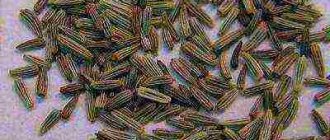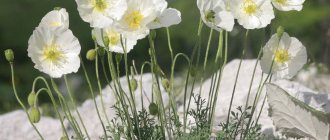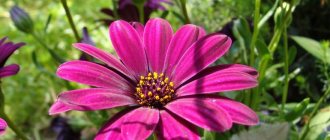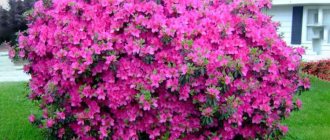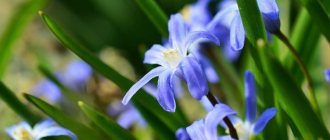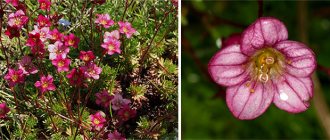Alpine star or edelweiss is a perennial plant growing in mountainous areas on rocks, limestone layers, and stone embankments. However, gardeners have managed to tame this amazing plant, so now planting and caring for edelweiss is not difficult even in a summer cottage. It reaches a height of no more than 30 cm and has a special appearance that allows it to be easily distinguished from other representatives of mountain flora.
In nature, the flower grows in poor soil, consisting largely of sand, gravel, and limestone. When planting it at home, you should not prepare fertile, well-fertilized heavy soil, as it will not grow in it. A light substrate that drains well is better.
Among the many varieties, gardeners recommend choosing leontopodium or alpine edelweiss, planting and caring for which will give results not only in alpine and subalpine climates, but also in the climatic zone of central Russia.
Reproduction and planting of edelweiss
Edelweiss from seeds for seedlings at home
Edelweiss seeds photo
Edelweiss is grown from seeds; seedlings are more reliable.
- In February or March, prepare a mixture consisting of two parts garden or deciduous soil, one part perlite, coarse sand.
- Sprinkle the flower seeds on top of the soil, pressing down with the palm of your hand.
- Water with a spray bottle, without over-wetting the soil.
- Cover the nursery with film or glass, maintaining the temperature at about 10 degrees.
- When seedlings appear, remove the cover and place the container with seedlings in a well-lit, warm place.
Edelweiss seedlings photo
- The seedlings will grow for a long time; upon reaching 2 cm, the seedlings are planted in separate pots for “growing”.
- Water moderately, not allowing the soil to dry out, but not flooding the plants, otherwise rot will appear.
Seedlings are planted in the ground at the end of April - beginning of May, maintaining a distance of about 15 cm between flowers.
Growing edelweiss from seeds in open ground
How to sow edelweiss in open ground Photo of seeds
In nature, light edelweiss seeds are carried by the wind and, when clogged in cracks between rocky soil, they easily germinate even in the absence of soil, if there is enough moisture. Therefore, when sowing, you should not bury the seeds too deeply; it will be difficult for them to break through the thickness of the soil.
In order not to fool around with the seedlings, sow the seeds directly in the already warmed soil, without the threat of frost, on the site - the “alpine hill”. Planting depth is 1-2 cm, the distance is as small as possible, after which you will have to thin out the seedlings, leaving 7-8 cm between them. Grown bushes can be planted less frequently, leaving 15-20 cm between them.
Edelweiss shoots photo
For both sowing cases, it is recommended to stratify the seeds for about three weeks - mix the seeds with moist soil and put them in the refrigerator in a bag for one to two weeks.
It takes about a couple of months to wait for seedlings, but under suitable conditions, seedlings can appear within a week.
Dividing the bush
Perennial bushes can be divided, acting extremely carefully, trying to injure the roots as little as possible. It is better to use a sharp garden tool or a well-sharpened knife. The bush is carefully dug up, trying not to disturb the ground, and cut into 2-3 parts with several growth points. The recommended distance between the resulting plants is 20-30 cm.
How to plant?
To begin with, let us clarify that edelweiss seeds can currently be found in Russia for free sale in specialized stores or on the Internet. However, do not think that if its natural growing conditions are so harsh, then it will “be happy” with any more or less acceptable soil. In fact, it is quite difficult to grow it in a personal plot. These are the requirements of Leontopodium.
- The soil must be dry, light, permeable, and contain limestone.
- No fertilizers! This plant does not like either organic matter or mineral supplements. And if you have “seasoned” the planting site with fresh manure, you can say goodbye to the idea of cultivating Leontopodium in your garden.
- Sufficient insolation. The capricious edelweiss, accustomed to growing in sunlit highlands, will not take root in a shaded place.
So, all 3 conditions are met. Now you can plant Leontopodium.
- At the end of winter or early spring, prepare the mixture by mixing 2 parts of garden or foliage soil and one part of perlite or coarse sand.
- Scatter the seed material over the surface, slightly pressing it with your palm.
- Irrigate with a spray bottle to prevent oversaturation of the soil with moisture.
- Cover the container with cellophane or a glass plate, maintaining a constant t = 10° C.
- After the first sprouts appear, remove the covering material by placing the container in a well-insulated, warm place.
- When the young growth reaches a height of 2 cm, plant the plants in different containers.
- Watering is only permissible in moderation, without drying out the soil, but also without flooding, in order to avoid the occurrence of putrefactive processes.
- Young edelweiss are planted around the end of April or beginning of May. A gap of at least 15 cm is maintained between plants.
In general, under natural conditions, Leontopodium reproduces by dispersing seed material by the wind. The seeds are driven into the cracks of the rock and grow there, not really needing proper soil. It is on this basis that when sowing seeds manually, it is not recommended to dig them too deep into the soil - it will be difficult for them to germinate through a thick layer of soil. If you don’t want to bother with seedlings, you can try sowing the seeds directly into open ground. As a rule, this requires the presence of an alpine slide in the garden.
In the spring, when the threat of frost has passed, sow your hill with edelweiss seeds. Remember to prohibit excessive deepening - 1-2 cm will be enough. You should not thicken the plantings, otherwise thinning will be required later. The optimal distance between seeds is 8 cm. Whatever planting method you choose, it is recommended to carry out preliminary stratification of the seed material: mix it with moistened soil and hide it in the refrigerator for 7-14 days.
Description of the Edelweiss flower
The plant is completely covered with dense fibers that prevent moisture evaporation, protect against cold and give it a white-silver “luminous” color. They occupy an area of 15-25 cm, tightly entwining the ground with many roots. Flowering - baskets of white or yellowish flowers without fragrance, collected in inflorescences, surrounded by star-shaped perianths.
It blooms in gardens from June to August, forming small rosettes of leaves by autumn. To propagate, carefully separate the tenaciously intertwined roots.
Edelweiss in landscape design
Edelweiss what to plant with Combination with other flowers photo
Edelweiss is wonderful for rock gardens, good for planting in groups, but you should not plant them with bright flowers, otherwise their beauty will be lost.
Edelweiss flower description photo with Alpine asters
Retaining color and shape for a long time, they are suitable for dry winter bouquets - cut off the flower stalks before opening and dry in a well-ventilated room, hanging the flowers down.
Edelweiss on an alpine hill
Edelweiss combines beautifully with alpine asters, arctic poppies, juveniles, blackheads, ornamental cereals, heuchera, and meadow sage.
Edelweiss in a flower bed with other flowers, what to plant with
Beneficial features
Edelweiss has excellent antioxidant effects, promotes rapid skin regeneration, prevents aging and is an aniseptic. It is thanks to these healing properties that edelweiss extract is widely used in the cosmetology field. But we must not forget that for cosmetological purposes, flowers are grown specifically and not collected in the wild.
Edelweiss is also very popular in floristry. Any bouquet with this unusual plant will look luxurious. In bouquets and when decorating flower arrangements, edelweiss is used both live and dried. Moreover, it does not lose its beauty in any case.
The Legend of Edelweiss
Once upon a time, on the tops of the Alpine mountains, there lived an incredibly beautiful fairy girl who fell in love with a charming young man who lived at the foot of the mountains. The young man could not climb so high into the mountains, and the fairy had no right to go down. The fairy grieved, and the tears rolling down the mountain slopes turned into an extraordinary flower. There are many other legends about the origin of edelweiss, telling about great love, bravery and courage, because the places there are harsh! In search of a flower one needs to spend many days in the mountains, so they imagine that if a man gets a flower for his beloved, this means his true feelings and devotion.
The name “Edelweiss” consists of two German words “edel” - nobility and “weiss” - white, which literally means “noble whiteness”. This is a truly noble and delicate flower that deserves the attention of gardeners.
It’s good that the miracle flower is now available to everyone, you just need to try a little!
Modest and unpretentious edelweiss is able to decorate even the most demanding alpine hill with its unusual appearance. Translated from Latin, its name sounds like “lion's paw.” This is due to the original shape of the pubescent flower. One of the many varieties of plants of this genus is alpine edelweiss, the photo of which you see below. It is very decorative, but not so difficult to grow and care for.
Description of the plant
As you can easily guess from the name, this species grows in the subalpine and alpine zones of Europe, Asia Minor and Central Asia. The plant can also be found at lower altitudes relative to sea level. However, under such conditions it loses its decorative felt pubescence. Alpine edelweiss grows on exposed limestone, gravelly slopes, cliffs and cornices.
This is a herbaceous plant with slightly curved stems, forming compact bushes 20 to 30 cm high. They sometimes branch in the upper part. The leaves of this variety of edelweiss are lanceolate, forming a beautiful basal rosette. Flowers of unusual shape (foot-shaped) are collected in baskets that form scutes. The fruit is an achene. Flowering lasts only two weeks in mid-summer.
The entire plant as a whole is very pubescent. Alpine edelweiss has a beautiful silver-green hue. In nature, this property serves as a special adaptation to the cold highland climate with constant fog. The plant is often depicted on coats of arms, coins, and postage stamps. There are even Roman tombstones from the beginning of our millennium depicting flowers. Edelweiss is considered a symbol of mountains, inaccessibility, and survival.
Varieties and varieties
The edelweiss genus includes more than 30 species of this plant. They are very similar to each other. The most common types are:
Alpine
This is the most common type of edelweiss. Its height in gardeners' plots varies from 10 to 20 centimeters. The inflorescences of mountain edelweiss consist of corymbs collected in baskets. The leaves around them seem to be painted white due to the thick felt pubescence. To preserve the characteristics of the species, it must be propagated vegetatively.
See also
Description of the dahlia variety Cheerful Guys, growing technology and careRead
Two-color
Two-color edelweiss bushes consist of erect shoots. They reach a height of 35 centimeters. White and yellow flowers, framed by leafy spears of varying lengths, bloom in July.
Kuril
This is a low-growing type of edelweiss. Its length barely reaches 20 centimeters. The basal leaves are oblong, about 7 centimeters long. The stem leaf plates are smaller, felt-like, and gray in color. The bracts forming a star are pubescent with white or yellow felt. Yellow funnel-shaped flowers bloom in late July - early August.
Additional Information. Edelweiss is considered the symbol of Switzerland. The inhabitants of this country call her the Queen of the Alps.
Use in horticultural culture
Because of its beauty and originality, edelweiss has been used by humans in gardening for a long time. It is especially relevant when creating rock gardens and slides. It looks good when planted in the foreground in small groups. The high decorative value of the plant remains even after the end of the flowering period. Cut edelweiss can stand in water for a long time. When dried, it does not lose its shape or silver color, so it is often used in winter “dry” bouquets. The best neighbors for him on hills and in rock gardens will be miniature (dwarf) rose bushes, ageratum, aquilegia, violet and alpine aster.
Features of flower care
Edelweiss is a rather whimsical plant; planting and caring for it requires quite a bit of effort, but if all maintenance standards are followed, good results can be achieved.
What humidity does edelweiss like, how often to water the plant
Edelweiss does not like high humidity. Moderate watering is suitable for it, and only in dry months.
Important! From excess moisture, edelweiss can die
A little about feeding edelweiss
It is highly undesirable to feed edelweiss. It does not tolerate any type of fertilizing: both organic and chemical. He is especially afraid of fertilizing with humus.
The plant can be fed only if it is frozen, and then only in order to restore it. After the plant has come to life, fertilizers cannot be used.
Soil care
Edelweiss, in addition to soil fertilized with limestone, likes to germinate in snow. Therefore, in the spring, before it warms up, throw a pile of snow on the old branches of the plant. But if you live in a region where there is no snow, then in winter you need to mulch the soil. This will create an imitation of snow cover for the plant. The mulching will need to be removed before spring.
Sources
- https://orhide.ru/?p=5788
- https://www.syl.ru/article/184308/new_edelveys—tsvetok-okutannyiy-legendami
- https://www.glav-dacha.ru/posadka-i-ukhod-za-edelveysom/
- https://koffkindom.ru/chto-vazhno-znat-ob-edelvejse-obshhie-svedeniya.htm
- https://1decor.org/rasteniya/cvety/edelvejs.html
- https://florantino.ru/cvetok-edelvejs-opisanie-i-foto-rasteniya.html
- https://dacha-posadka.ru/grunt/edel-veys-al-piyskiy-posadka-i-uhod-v-otkrytom-grunte.html
- https://klumbavsadu.com/tsvetok-alpijskij-edelvejs-vidy.html
- https://pion.guru/tsveti/edelveys
- https://3vedra.ru/cvety/edelvejs.html
- https://fb.ru/article/285166/alpiyskiy-edelveys-vyiraschivanie-i-uhod
- https://agronomu.com/bok/1162-kak-vyrastit-edelveys-v-sadu-posadka-i-uhod-za-cvetkom-gor.html
Choosing a location and soil for the plant
It is completely logical that the alpine edelweiss flower prefers well-lit, sunny places. The plant is drought-resistant; moreover, it absolutely does not tolerate waterlogging and stagnation of water in the soil. For edelweiss, light, well-drained soils are most optimal.
When planting a plant, it is advisable to add leaf soil, coarse sand or crushed stone. This will help create conditions as close as possible to those in which it grows in its natural environment. Do not use heavy soil or overly nutritious substrates with a high organic content. Combined with high humidity, this will lead to a loss of decorative appearance of the plant, including beautiful pubescence, and strong elongation of shoots.
Chemical composition and application
Edelweiss grass is rich in minerals: calcium, potassium and magnesium, as well as vitamins A, C and K. The plant contains tannins, flavonoids, chlorogenic and phenolic acids, which have pronounced antioxidant properties.
The plant is not included in the State Pharmacopoeia of the Russian Federation, however, traditional medicine, especially Tibetan, uses edelweiss preparations internally to treat diseases of the respiratory and digestive systems, and externally to combat long-term non-healing ulcers and burns. Mountain flower is also used in cases of:
- cholelithiasis;
- angina pectoris;
- hypertension;
- rheumatism;
- whooping cough
Folk legends, in which beauties demanded that their grooms get edelweiss, reflected the flower’s ability to maintain cell youth. It is added to creams and lotions to care for problem skin.
Alpine edelweiss: cultivation
The plant belongs to the category of unpretentious. However, to grow it in your garden, you will have to make some efforts. At first glance, the flower seems inconspicuous. Indeed, if you plant it in a company with tall perennials, nothing good will come of it. Firstly, he will not have enough light. Secondly, he will simply get lost among them. Edelweiss needs to be emphasized with a suitable environment, highlighted on a hill with the help of stones, and a small group of plants created - only then will it attract attention.
As mentioned above, the plant does not like excess moisture. Therefore, it has enough natural precipitation. Moreover, if the summer is very rainy, then it should even be covered. Only in hot and dry months does edelweiss need to be watered additionally. The second important component of plant care is weeding and loosening (very superficial so as not to damage the roots).
Young alpine edelweiss at the age of 1-2 years needs light shelter for the winter. You can use fallen leaves or branches of coniferous plants. In spring, the shelter should be removed as early as possible so that the shoots are not blocked. The plant grows well in soils rich in lime. Therefore, do not forget to periodically feed it with all the necessary microelements during the active growing season.
Medicinal properties and harm
Alpine and Siberian edelweiss is usually used for medicinal purposes. The chemical composition of these plants determines their properties:
- anti-inflammatory;
- anticonvulsant;
- antioxidant;
- expectorant;
- anti-stress;
- tonic.
Leontopodium strengthens the immune system, which helps prevent colds, allows you to successfully resist toxins, and slows down the natural aging of the body.
No harmful or toxic substances were found in the plant; there are no contraindications to its use. Its drugs are not recommended in case of individual intolerance, and in cases of pregnancy and lactation, consultation with a doctor is required.
Plant propagation methods
Edelweiss can be propagated in two well-known ways: vegetative and seed. Moreover, each has its own advantages. During seed propagation, the original characteristics of the plant are lost, that is, those that it possessed in its natural growing environment. This causes the flower's appearance to vary greatly depending on where it is grown. Therefore, in order to preserve the characteristics of the variety, use the vegetative method. It is quite simple and clear.
Vegetatively, alpine edelweiss is propagated in spring or autumn by cuttings or dividing the mother bush. In autumn, an adult specimen consists of several annual rosettes, which are very tightly intertwined with each other by roots and are essentially independent plants. They are carefully separated and seated in a new place. Young edelweiss will bloom in the summer following winter. The tops of the shoots are suitable for cuttings, but not too old. They take root easily in the spring (May-June), and bloom the following summer.
How to protect flowers from aging
During the period when edelweiss blooms, having reached a year and a half, it is considered their youth. It's a shame that after a couple more blooms they become mature and begin to age. To protect them from this and preserve them in the rock garden, you need to start the propagation procedure by division. To do this, in early spring the bush is dug up and divided into 10 or more parts. All parts can be planted by propagating the plant in this way. But in a few years, when the flower fills all the necessary places, you will have to get rid of unnecessary parts, sending them to compost or delighting your friends with exotic seedlings.
Rejuvenation is the key to good growth and beautiful appearance. Edelweiss, planting and caring for (photo) which prevents the division of the bush, will begin to die in five years. After all, it does not grow over the area of the flower bed, and at the same time it practically suffocates itself with roots.
Alpine edelweiss: growing a flower from seeds
In order to grow a flower, you need to go to the store and buy a bag of seeds. Sowing is carried out in February-March in light nutrient soil. The container with the crops is covered with glass to preserve moisture and heat and placed in a shaded place. Seed germination temperature is 13-15 °C, the first shoots can be observed in 2-3 weeks. After there are more of them, the shelter is removed and the container is transferred to a bright place. Seedlings grow quite slowly. The main thing during this period is not to flood them. Plants that have reached a height of 2 cm are planted in separate pots.
Frankly speaking, edelweiss, compared to many other flowers, is not at all striking in beauty. But this is only at first glance. This small flower is shrouded in many secrets. In particular, it has long been considered a symbol of love, fidelity, and courage. Perhaps because once upon a time men, risking their lives, tried to get this flower high in the mountains for their loved ones. Therefore, it is not surprising that you really want to conquer this “highlander” by trying to grow it on your own plot. Read this article on how to do it with minimal effort.
Edelweiss , or Leontopodium, is a genus of herbaceous plants of the Asteraceae family, common in the highlands of Europe and Asia.
Alpine edelweiss (Leontopodium alpinum). © Hurni Christoph
What is edelweiss?
Not very bright. Therefore, if you plant it among roses, gladioli or phlox, the edelweiss will simply “get lost.” But if you create the appropriate conditions for it on your site by placing it on an alpine hill, that’s a completely different matter. By the way, alpine edelweiss can only be found in the Carpathians and the Alps, where it grows at an altitude of 1700-2000 m. There is also a Siberian species - Palibin edelweiss (Leontopodium palibinianum), growing in the mountains of Siberia, Mongolia and Korea, it is larger than the alpine one.
Alpine edelweiss (Leontopodium alpinum) according to modern classification is considered a subspecies of snowy edelweiss (Leontopodium nivale) - Leontopodium nivale subsp. alpinum.
Often Siberian edelweiss is called a subspecies of the plant “Pink cat's paw” (Antennaria rosea subsp. confinis), which is incorrect from a botanical point of view.
The leaves and stems of edelweiss are covered with grayish-felt pubescence, which protects the plant from excessive evaporation of water - this is how nature wisely ordered it. The flowers are mostly snow-white. Inflorescences are baskets collected in dense heads. They are usually surrounded by a “star” of apical leaves. In France, the plant is called the Alpine star. At the same time, the inflorescences vaguely resemble the imprint of a lion's paw. Therefore, the scientific name - Leontopodium - translated from Greek means a combination of the words “lion” and “leg”. The common name "edelweiss" comes from the Greek words for "noble" and "white." Blooms in June-August.
Edelweiss care
Edelweiss does not require special care. This is an annual or perennial light-loving, drought-resistant plant. Prefers light, dry, calcareous soils and does not tolerate stagnant water. Since this is a true mountain resident, it is advisable to add crushed stone or coarse sand to the soil when planting.
Unlike many other flowers, edelweiss does not benefit from rich soil. Because of this, it loses its decorative effect. At the same time, it thrives on poor soils, in crevices between stones.
Edelweiss Palibina (Leontopodium palibinianum). © T.VoeklerPropagation of edelweiss
Edelweiss is propagated most often from seeds, preferably by seedlings, sowing it in February-March in a soil mixture of deciduous soil and sand (2:1). The seeds are not deepened, but scattered over the surface of the soil. The box is covered with glass or film, which is removed when shoots appear. Plants grow slowly.
At the end of April and beginning of May, seedlings can be planted in open soil. You can propagate edelweiss by dividing the bush in spring or autumn. True, edelweiss bushes are very closely intertwined with their roots, so when dividing they should be taken apart very carefully. They will bloom next year. Plants can grow in one place for 2-3 years. So that they do not lose their decorative properties, they should be transplanted to another area.
Snowy edelweiss (Leontopodium nivale). © Bjorn SPartners for edelweiss
The height of edelweiss is 15-20 cm, so it is so important not to “crowd” it with other plants. Its partners can only be such low crops as alyssum, gypsophila, tenacious, sedum and other ground cover plants.
If you manage to grow edelweiss at home, you can rightfully be proud of it. In addition, the plant is listed in the Red Book, and therefore it is necessary to protect it and promote its spread. In addition, even in winter, edelweiss can delight you with its beauty, since it is often used as a dried flower for making winter bouquets. At the same time, it retains its shape and silver color.
Poets have created many legends about edelweiss flowers - about courage, loyalty and love. The plant itself resembles miniature mother-of-pearl pearls or silver radiant stars scattered by nature along the rocks of snow-capped mountain peaks. "Alpine Star" in France, or "Silver Flower of the Rocks" in the Italian Alps grows on mountain slopes with unenriched soils or on rocky soil.
Types of splinters
There are about 200 species included in the genus of geraniums, only a few of which are actively cultivated as garden species. The different species are very similar in appearance, although their growing requirements may still differ slightly.
Jaskolka Bieberstein
If you see a moth in someone's garden within Russia, then most likely it is the Bieberstein moth (Cerāstium Bieberstēinii), since it is the most common. In the wild, this species is found only in the Crimea; it chooses rocky slopes for habitat. The height of the plant is 15–20 cm, the leaves are pubescent, narrow, up to 3.5 cm long. Snow-white flowers can reach 3 cm in diameter. Bieberstein's cherry blossoms bloom at the end of April and delights with snow-white flowers until the end of May. The plant is listed in the Red Books of several countries (Ukraine, Russia (Crimea), European countries), and is also found in nature reserves. This flower was successfully introduced into gardening due to a lot of unique qualities:
- high decorativeness,
- winter hardiness,
- unpretentiousness,
- ease of reproduction,
- excellent survival rate.
Bieberstein's parsley looks very decorative during flowering
Felt cleaver
Tomentosum (Cerāstium tomentōsum) is another popular plant variety. It is found in Canada and is found in almost all European countries. The leaves are heavily pubescent and appear almost silver, especially if conifers or plants with bright green foliage are planted nearby. The tomentose plant reaches 30 cm in height and grows greatly in width, up to 60–70 cm. The flowers are small - up to 1 cm, but very plentiful. It blooms in May and blooms for a little more than a month - on average 30–35 days.
Felt lily with small flowers is well suited for framing retaining walls
alpine jasmine
Alpine chickweed (Cerāstium alpinum) is the shortest, reaching no more than 15 cm in height, but the flowers are relatively large - up to 2 cm. The stems are highly branched, the foliage is light, plentiful, small, green in color with a slight silvery tint. Blooms in May, 20–30 days. This species is more sensitive to growing conditions than others: in the conditions of the Middle Zone, it can freeze out in winters with little snow. And in general, the alpine woodworm is more capricious: it does not like direct sunlight and does not tolerate overheating of the roots or stagnation of water. In the wild it is found in the mountains of Altai, North America, and Western Europe. Choose this species if you live in a mountainous area with a temperate climate or are looking for a plant for an alpine hill or rockery.
Alpine jasmine grows naturally in the mountains
Purple parsley
Purple moth (Cerāstium purpurascens) is found naturally in Turkey, the Middle East, and the Caucasus. It blooms in June with white graceful flowers. The height of the plant is 25 cm, the leaves are small, oblong, and often remain green in winter.
Purple moth is common in the mountains of Iran, the Caucasus, and Turkey.
Grandiflora grandiflora
The large-flowered chickweed (Cerāstium grandiflorum) has the largest flowers - 3 cm, while the height of the plant is minimal - 20 cm. Unlike other species, it blooms late - in July or even August.
Grandiflora grows in mountainous areas and blooms later than other species of this plant.
Snow-white moth
The snow-white carp (Cerastium candidissimum) grows in Greece. Loves highlands. It blooms late - in May - July. In the Royal Botanic Gardens, Kew in London, you can observe entire glades of the snow-white moth. The plant is beautiful even without flowers; it is as decorative as a lawn - a real silver carpet.
The snow-white moth is found in the wild in Greece.
External description of the flower
Even an amateur gardener knows what an edelweiss flower looks like. It is a low growing herbaceous plant with beige-white flowers and attractive foliage. The average height is up to 35 cm, width - 22. The white bract, framed by a yellow edging, reaches 10 cm in diameter. Baskets of inflorescences are collected in dense heads. Edelweiss gradually expands as it grows thanks to self-seeding and creeping underground rhizomes.
Grows well both from seeds and from soil roots. The flowers are softly pubescent and stand out against the green-silver foliage. The Latin name was given to the plant for its external resemblance to a lion's paw.
The alpine flower looks great in borders. Blooming in late summer, edelweiss will delight the owner until the end of autumn. Then the dried inflorescences can decorate festive winter bouquets.
General characteristics of alpine flower
The baskets are painted in bluish-yellow tones, the rest of the petals are snow-white.
The inflorescences, like the whole plant, are densely covered with soft fibers, which gives it a silvery tint. In natural conditions, such a coating serves as a kind of protection from the cold climatic conditions of the mountains. Flowering occurs in late spring or summer, after which achenes with tiny flying seeds ripen. The roots of the plant are creeping, which is why it is able to grow independently. Edelweiss are perennial or annual herbaceous plants that have a height of 12 to 25 cm. The plant has leaves with a narrow, elongated leaf blade. The bottom of the leaf blade is covered with villi, which protect against excessive loss of moisture. The upper surface of the leaf blade is silvery in color.
The inflorescence of the plant is finite, complex, and consists of baskets twisted into dense formations. The baskets contain white flowers or flowers with a yellowish tint.
The baskets in the inflorescence are surrounded by linear leaves that have a star-spread shape.
Today, plant taxonomies include more than 60 species in the genus Edelweiss. Each type of edelweiss flower has external distinctive features that can be easily detected by comparing photos of flowers of different types.
The most common types of this plant are the following:
- Leontopodium alpinum;
- Leontopodium fauriei;
- alpine edelweiss;
- Leontopodium brachyactis;
- edelweiss Fedchenko;
- Leontopodium japonicum;
- Leontopodium leontopodioides;
- Leontopodium ochroleucum;
- Siberian edelweiss;
- edelweiss Palibina.
Flowering occurs from June to September. Plant development occurs on dry, poor and unfertilized soils. When the plant grows on soils rich in humus, rapid development of foliage occurs with a minimum number of flowers formed.
Plant propagation is usually carried out vegetatively, by dividing the rhizome. In addition, seed propagation is possible.
After the flowering period, the plant develops seeds. Flower seeds are small in size and equipped with flowers.
In late autumn, the mother plant dies off, and in its place remain annual rosettes that overwinter. The next growing season, these rosettes develop into full-fledged plants that begin to bloom.
It is a slow growing plant that blooms luxuriantly in high alpine conditions. This type of flower is a herbaceous perennial plant with beautiful foliage and beige-white flowers. In appearance they resemble daisies. This variety is native to southern and central Europe. It should be noted that this plant is quite spectacular, and there are even legends and songs about it. The flower is best suited for growing in rock gardens in cool to cold climates. Belongs to the Asteraceae family.
Tall edelweiss flowers in the photograph.
Photo of edelweiss on natural stones.
This type of edelweiss grows well in rocky, sandy soil with good drainage, which is why they are popular for use in rock gardens. They also look great in borders or planted in a mass to cover the soil in the garden. The plant begins to bloom in late summer, and flowering continues until early autumn.
Like all alpine flowers, edelweiss can grow well in poor soils, cold temperatures, and is resistant to winds and harsh sunlight. But despite this, plants grow rather slowly under not the most suitable conditions. Due to the fact that edelweiss trees are often removed from their natural habitat, their numbers are gradually decreasing.
Characteristics of popular varieties
There are more than 40 plant species in floriculture. Of these, only five varieties have reached widespread distribution:
- Edelweiss alpine . The terry apical leaves form a multi-rayed star. The pride of the Alpine edelweiss is the fleecy silver leaves of a lanceolate shape, forming a basal rosette. The stem of the plant reaches a height of 20 centimeters.
- Siberian . A genus close to the alpine grows in the steppe and mountainous regions of Korea, Mongolia and Siberia. Large bushes are decorated with miniature inflorescences. The plant develops in permeable, dry and unfertilized soil. Propagated by spring division of rhizomes or seeds in summer.
- Pale yellow . Single stems are covered with sparse oblong leaves. The edges of the leaves are curled and have a pale yellow or greenish color. The inflorescence star rarely has the correct geometric shape.
- Kuril . The flower, reaching a height of no more than 18 cm, is squat. Straight stems are decorated with felted drooping leaves. The shape is narrow-lanceolate.
- Two-color . The difference is soft felt leaves near the inflorescences. Distributed in Japan and Sakhalin. The variety prefers rocky sea slopes and river banks.
Spreading
Today, the number of naturally growing bushes is relatively low, which is why edelweiss is listed in the Red Book. In their natural environment, you can find edelweiss in the Alps or the Subalpine belt, high in the mountains. The culture lives on rocky terrain, among stones. It is quite difficult to get to the place where edelweiss grows, since the altitude of the bushes starts at 1800m above sea level.
Most varieties of edelweiss are found in the Carpathians and Alps, the Himalayas and Tibet. Some varieties grow in Mongolia and Siberia, where they also live in mountainous areas. The flowers living in this area are slightly larger than the alpine representatives.
Features of growing a plant
The stereotype that edelweiss grows only high in the mountains has long been refuted. Many modern gardeners cannot imagine a garden without mysterious alpine inflorescences.
Useful tips for gardeners
If you decide to grow this beautiful flower in your garden, you should know some of the features of its “character”. They will help you avoid mistakes and get a great landscape decoration:
Also
- The flowering time of edelweiss depends on the variety. It can begin in June and end in August or even at the very end of autumn.
- When planting on a home plot, coarse grained sand or fine crushed stone should be added to the soil due to its mountain origin. This will allow conditions to be as close to natural as possible.
- Edelweiss simply does not need nutritious soil rich in minerals. It will oppress the plant. There will be a loss of decorative properties.
- The optimal fertilizer will be humus. It is recommended to apply it in the first weeks of spring, when the flower is most weakened.
- Open compositions and sunny places benefit the alpine flower. It produces many shoots and the inflorescences become larger.
- Edelweiss is resistant to winds and even bright sunlight.
- In the wild, all representatives of the alpine flora spend the winter under the snow. If a gardener wants to see edelweiss in his rock garden, where there is no precipitation, then they need to be mulched, creating an imitation of snow cover. It is recommended to remove mulch at the very beginning of spring.
- You should carefully choose neighbors for your flower. Tall and lush roses, phlox and gladioli are not the best option, since the edelweiss will get lost against their background. Sedum, gypsophila and alyssum will fit perfectly into the composition.
Methods for propagating edelweiss
It will be easier for beginners and amateurs in gardening to buy ready-made seedlings and start planting them. Experienced gardeners prefer sowing seeds. Edelweiss propagation has important nuances:
- Parachute seeds are completely ready for planting at the end of February and beginning of March.
- The optimal soil mixture consists of deciduous soil and sand in a 1:1 ratio.
- The seed is not buried inside the soil. It is enough to scatter them over the surface of the box. The container must be covered with glass or tightly filmed, removed only when the first shoot appears.
- In early May, the seedlings are ready to be transferred to open soil. In autumn, you can propagate the flower by dividing the bush. The only difficulty is the dense intertwined root system.
- The first shoots will begin to break through the ground 2 weeks after planting, if the air temperature is within 16 degrees.
- It is important not to allow the soil to become waterlogged—avoid overwatering.
- Edelweiss needs to be replanted at least once every three years. This helps maintain and enhance decorative properties.
Diseases and pests
Edelweiss is resistant to most various diseases, thanks to natural hardening. When grown in garden conditions, the crop is sometimes damaged due to excess moisture. To avoid excess moisture, gardeners recommend organizing regular watering of edelweiss, or planting the crop near coniferous plants. You should not overdry the soil, as this can lead to drying out and stunting of development.
Most often, edelweiss is damaged by pests such as aphids or slugs:
- Aphids—for a flower, it is not the insects themselves that are dangerous, but the larvae that settle on the stems and foliage, feeding and destroying the crop.
- Slugs are larvae that suck the juice or stems and leaves, causing damage. Symptoms of slugs include wilting of the plant and the appearance of slugs on the plant.
You can remove slugs manually. The appearance of aphids often leads to the death of the plant. For prevention, edelweiss is treated with insecticidal solutions during the active growing season of the plant.

